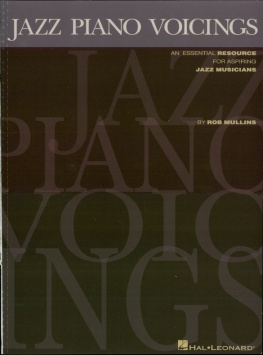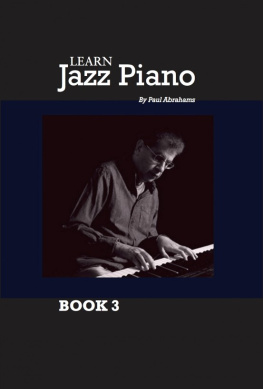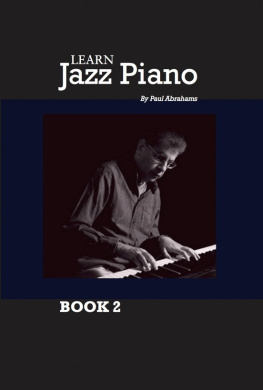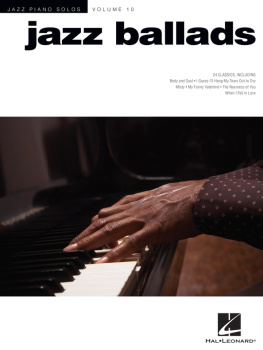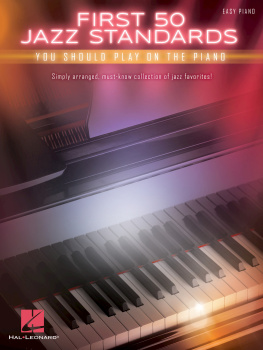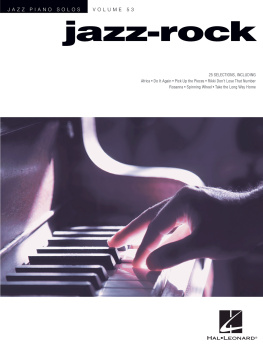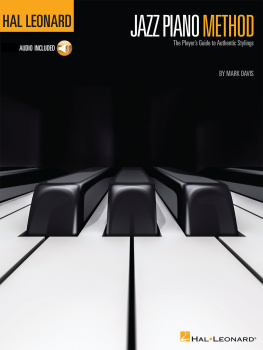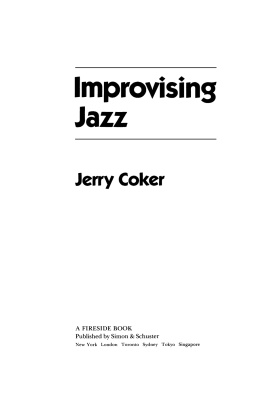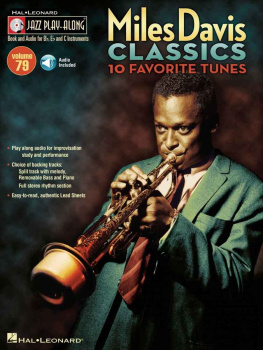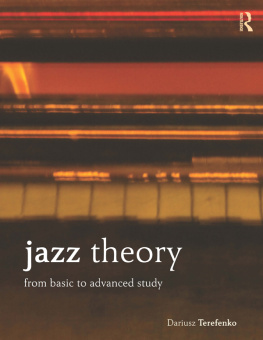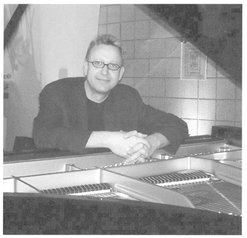ABOUT THE AUTHOR
ROB MULLINS has been a jazz pianist and educator for 25 years. Starting out as a big band drummer in 6th grade, Rob toured Southern California with a pro big band and learned piano, sax, guitar, and bass during high school after a move to Colorado. He attended University of Colorado on a percussion scholarship and left college to study theory and composition with George Russell (Miles Davis, John Coltrane, and David Bakers theory teacher) in New York.
Rob received a Grammy Nomination for his Soulscape album in 1986 and has subsequently recorded 13 more solo albums in the straight ahead jazz, contemporary jazz, solo piano, and space rock genres. Rob began his teaching career at age 14 at Happy Logan Music in Denver Colorado and taught professionally throughout his career as a session musician and touring professional. Most recently in the educational arena he has been hired by the University of Utah to teach a workshop on piano voicings as part of the Salt Lake City International Jazz Festival. He taught a workshop on Film and Television Composition at Fields Pianos in Los Angeles California and was hired by Dr. Greg Woll to coach his Downbeat Magazine Award winning Woll of Sound Big Band at Fullerton College in Fullerton, California. He has also taught private lessons over the years most recently at Pedrini Music and the Piano Factory in the Los Angeles area and offers a wide curriculum of study including jazz theory and composition, jazz piano, improvisational classes for all instruments, MIDI and computer composition, singer/songwriter coaching, music for television and film, and music business classes.
Robs unique approach to piano instruction from the drummers and composers perspective has led to this book which is the result of years of study, live performances, and constant honing of his student approach in learning situations. Robs live performances over the years with jazz artists such as Hubert Laws, The Crusaders, Dianne Reeves, Dianne Schuur, Eric Marienthal, Harvey Mason, Gerald Albright and Ndugu Chancler have been complemented by his rock and blues gigs with Edgar Winter, Billy Preston, Bruce Willis, Eddie Money, Buddy Emmons, Hoyt Axton and The China Club All Stars.
His work as a MIDI and keyboard specialist has been heard on The King Of Queens (CBS television), Sister Sister (WB), Moesha (UPN), and The Proud Family (Disney). On these shows Robs piano performances were featured and his drum, bass, and synthesizer programming were also in evidence in the jazz, orchestral, rap, hip hop, drama, suspense, and sports categories of broadcast music.
Robs keyboard voicings and compositions can be heard on his Yamaha Disklavier CD, Welcome to Planetmullins! which is distributed worldwide by Hal Leonard Corp.
Additionally, Rob was honored in November 2003 with the prestigious Jazz Artist of the Year Award at the LA Music Awards at its 13th annual awards ceremony celebrating indepent artists.
Now after many years of preparation, Rob offers the best of his study of jazz keyboard voicing in an easy to understand yet comprehensive collection of the most popular voicings for the most used chords in jazz. Included in this book is an invaluable chart of voicings for the producer, studio engineer, rap or hip hop artist who doesnt read music, but wants to add a jazzy flavor to his or her productions. Also, Robs pioneering style and hands on approach to the bass line and rhythm makes these voicings and exercises an integral part of the rhythm section and big band jazz pianist.
For more information about Rob, visit his website at http://planetmullins.com.
Final Notes
The whole point of this book is to improve the harmonic quality of the universe. Towards that end, jazz harmonies played correctly do much to achieve that end. To hear these voicings in action you might want to check out my CDs at http://planetmullins.com. Also, remember that there are a million ways to play chords, try adding any scale tones in the right hand to the cool stuff in your arsenal of left hand voicing now and seeing what you can come up with. The creative possibilities are endless.
Rob Mullins
LA, CA April 2002
1. Why I Wrote This Book
As I go into my 20th year as a performer, educator and recording artist, Im still surprised at the continuing amount of trouble that many musicians have with the jazz idiom. Jazz was something that came easily to me first on drums, which was my primary instrument, and then on piano. I was lucky enough to have a great jazz educator in my life during high school who helped me figure out the names of the chords I was playing off of the records I was listening to at the time. From making tables of voicings of the individual chords I was hearing, I was able to figure out what the chord names were and to start using them in my playing.
I became a music teacher during high school helping people learn jazz and always found it easier to write out my own voicing exercises for students than to refer them to books that were available. Now in 2002, I am proud to present the voicings I have been showing students over the years in private lessons so that they could rapidly develop skills in the jazz medium and start sounding professional right away without years and years of study.
The voicings in this book represent the culmination of the most basic voicings of the pianists I listened to in my early years as a musician......George Shearing, Count Basie, Tommy Flanagan, Dave Brubeck, Bill Evans, Oscar Peterson, Keith Jarrett, Herbie Hancock, Chick Corea and others. Here they are in print for you to study.
The best thing about the voicings here in this book is that they make even the most simple lines played in the right hand sound very very good. A student in the formative stages of melodic concept will sound great playing these voicings in the left hand, and you will hear them in use constantly as the staple voicings of most professional jazz pianists on the scene.
2. How to Use This Book
This book is designed with solo, duo, trio, quartet, big band, etc playing in mind. The exercises for Positions I and II are to be learned with the left hand playing the bassline, and the right hand playing the voicing. Position three exercises are the comping position with the voicings you learned in position I played by the left hand, and chord tones played on top of them in the right hand. In order to play all the notes written in Position III exercises, you will need to pre-record the basslines or do the best possible thing: have a bass player play the bassline while you play the voicing with two hands. Bass players are the pianists best friend in jazz and bass players can double the basslines written in the Position I and II voicings and also play the basslines in Position III exercises while you play the two handed voicings as written.
Work on the voicings by yourself first, or with a good teacher and then get a bass player to come do them with you. Hope that he doesnt leave while you are doing the dim7 chords because of the tension caused by their sound (thats a joke). A great way to do Position III voicings is to play the bottom four notes in the left hand hand and try to improvise with the right hand after you have learned to play the voicing as written. You can also use Position III voicings for a big sound in any jazz group situation.

